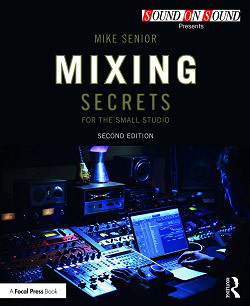Mixing Secrets For The Small Studio - Additional Resources
Chapter 4: Staying Objective
Table of Contents
Audio Files
(To download all WAV examples at once: 5MB ZIP)
- Effects Of Monitoring Volume: If you don’t check how your work sounds at a selection of appropriate monitoring volumes, then your mix’s overall tonality is more likely to be skewed on account of your ear’s level-dependent frequency sensitivity, as in these examples of real-world home-studio mixes submitted to Mix Rescue: a mix monitored too loud Ex04.01: WAV/MP3play_arrow and a mix monitored too quiet Ex04.02: WAV/MP3play_arrow.
Links
Affordable Stereo Monitor Controllers: As mentioned in the book, a dedicated monitor controller is an excellent purchase for the small studio, and for mixing purposes I’d recommend a model with the following features: three independently switchable monitoring outputs (for your nearfields, Auratone-substitute, and grotboxes); a headphone socket; and a mono switch. Here are a few options which fit this spec at a reasonable price: Audient’s Nero; Mackie’s Big Knob series (just count those double entendres in the original Sound On Sound Mackie Big Knob review!); the Presonus Central Station & Monitor Station; and SPL’s MTC (which I use myself), 2Control & Control One. There are cheaper options too, but bear in mind that build quality and ease of repair are important considerations for monitor controllers given that their pots and switches inevitably get a lot of wear.
Automatic Loudness-matching Plug-in: Adjusting the levels of different reference tracks to match your mix in progress can be a chore, but there is an affordable plug-in from Klangfreund that can help by analysing the tracks during playback and adjusting the channel gains automatically: LUFS Meter

 . It’s very easy to work, and I use it all the time these days.
. It’s very easy to work, and I use it all the time these days.A-B Switcher Plug-ins For Mix-referencing: Here are a couple of affordable A-B switcher plug-ins specifically designed for mix-referencing purposes: Mastering The Mix’s Reference

 and Melda’s MCompare
and Melda’s MCompare
 .
.High-resolution Lossless Audio Downloads For Referencing: For referencing purposes, it makes sense to get hold of audio in the highest quality you can. The Qobuz site has lossless CD-quality (or higher!) downloads of pretty much everything you could ever want (certainly anything even slightly mainstream) and you can often buy single tracks rather than whole albums too.
Further Reading
Suggestions For Reference Material: The Honor Roll of Dynamic Recordings, from the Digital Domain web site of Bob Katz. Some suggestions from Sound On Sound’s Hugh Robjohns in his article ‘Creating A Test CD’. Vestman mastering’s list of suggested commercial reference CDs. For further ideas, check out the Sound On Sound Forum and the Gearspace forum. Here are a few example threads to get you started: SOS Forum thread 1, SOS Forum thread 2, SOS Forum thread 3, Gearspace Forum thread 1, Gearspace Forum thread 2.
Using A Calibrated Reference Monitoring Level: Some engineers argue for setting up a constant reference monitoring level using a sound-pressure-level meter. Although I’m not personally convinced of the value of this approach myself, here’s a good Sound On Sound magazine article about it if you want to experiment with the idea further: ‘Establishing Project Studio Reference Monitoring Levels’.

